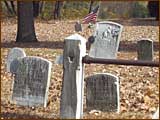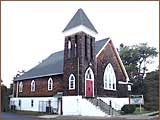WHO WAS PETER MOTT?
And Why Does His House Matter?

By Hoag Levins ...| ...October 14, 2001

LAWNSIDE, N.J. -- Born around 1810 in slave-holding Delaware, Peter Mott made his way across the Delaware River to New Jersey as young man.
There, ten miles east of the river city of Camden, he settled in a remote and

|
| Photo: Hoag Levins. |
|
Peter Mott died in 1881 and is buried in this small cemetery behind Mt. Pisgah A.M.E. church in Lawnside. His grave marker is no longer visible.
|
|
heavily-wooded rural community called "Free Haven" that later changed its name to Lawnside. He married Elizabeth Ann Thomas in 1833. She had been born in Virginia before coming to Free Haven.
Self-made man
A self-made man, Mott built a house, established a small farm, provided trade services in nearby towns, and engaged in other local businesses. Meanwhile, he and his wife risked everything to help fugitive slaves move through New Jersey toward northern states and Canada where they would be beyond the legal reach of their former owners.
County records show that Mott eventually bought and sold a considerable amount of property in the area. In about 1844, he constructed a two-story house from which he ran his farm. On census records, he listed himself as a farmer, a plasterer and a laborer.
He was also an ordained minister in the African Methodist Episcopal Church and the first superintendent of the Sunday School at Free Haven's Mount Pisgah AME Church -- a congregation that today remains a central institution of Lawnside.
Local oral history
Oral stories passed down through generations of Lawnside families
indicate that Mott harbored runaway slaves on his farm and then ferried them in his horse-drawn wagon to their next stops in the Quaker communities of Haddonfield and Moorestown.
Attended by a doctor from nearby Haddonfield, Mott died in Free Haven on Nov. 28, 1881, and was buried in the cemetery of Mt. Pisgah Church.
His house, now a museum, is the oldest structure in Lawnside and a historic site with rare qualities.
As Lawnside Historical Society President Linda Waller explained:
"One of the most important aspects of this property is that it was built and owned by a free black man in the 19th century and was involved in the Underground Railroad."
Very rare site
"It is very rare that you find an African-American Underground Railroad site -- property owned by a person of color and in an African-Amerian community. That just makes this that much more powerful; I'm not sure that there is any other place exactly like this in the United States."
"Peter Mott and others like him felt compelled to say 'I freed myself but I need

|
| Photo: Hoag Levins. |
|
Peter Mott was a minister at the Mt. Pisgah A.M.E church which is still a central institution in Lawnside.
|
|
to help others to freedom' and he and they did that at great risk to themselves," Ms. Waller said.
"When a New Jersey Historic Preservation officer inspected the house in 1989, she said it is a rare surviving example of a black man's home in a free community in the 19th century. That fact that it had two stories indicated to her that Peter Mott was a man of means. He was a businessman who had a lot to lose. But there is a scripture that says "To whom much is given, much is required,' and he probably felt that commitment.
Slave-catching bounty hunters
Oral stories recount how slave-catching bounty hunters roamed the the area in search of runaways but were consistently frustrated or thwarted by local residents in the all-black community.
"His property was pretty extensive at the time and a lot of it was wooded," said Ms. Waller. "In fact, we were always taught in school that one of the things that made this community so amenable to fugitives back then was that it was in such a densely wooded area.
Now that the Mott House was open as a museum, she said, the next phase of the Lawnside Historical Society's program was to seek out academically-trained historians who could help with in-depth research about the Motts and the period in which they lived.
Haddonfield and Lawnside
"Local historical organizations -- like the Haddonfield Historical Society and the Camden County Historical Society -- have already been wonderful to us," Ms. Waller said. "Haddonfield and Lawnside have always been very interrelated because many of the people here worked there and many of the people there were Quakers who actively opposed slavery.
"Haddonfield has some great documents from the era," she explained. "My sister found her husband's great grandmother listed in records from the Quaker 'Mothers' Meeting.' The Quaker women would come and meet here with newly freed women and talk about issues like homemaking and scripture reading and sewing and singing. They would distribute small allotments of soap and fabric. Some of the women took meticulous notes of these meetings that are still on file in Haddonfield.
"We need to systematically locate all the documents like this that can shed further light on what daily life was really like back then," she said. "Our goal is to make this piece of history a living reality in our museum."
| 


